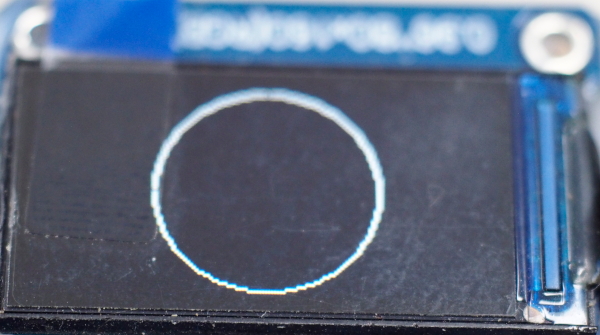บทความก่อนหน้านี้ได้กล่าวถึงการปรับปรุงปรับปรุงความเร็วในการแสดงผลด้วยการใช้เทคนิคดับเบิลบัฟเฟอร์ (double buffer) จึงนำมาประยุกต์ใช้สำหรับการแสดงผลเป็นนาฬิกาแบบแอนาล็อกดังภาพที่ 1 ซึ่งวิธีการวาดนั้นใช้การคำนวณตรีโกณมิติเพื่อหาค่าพิกัด (x,y) ของปลายเข็มวินาที นาที และชั่วโมง โดยการทำงานของแต่ละวินาทีจะใช้ตัวตั้งเวลาหรือไทเมอร์ (Timer) เพื่อให้การทำงานนั้นใกล้เคียงกับเวลาจริงมากกว่าการวนรอบหรือการหน่วงเวลา
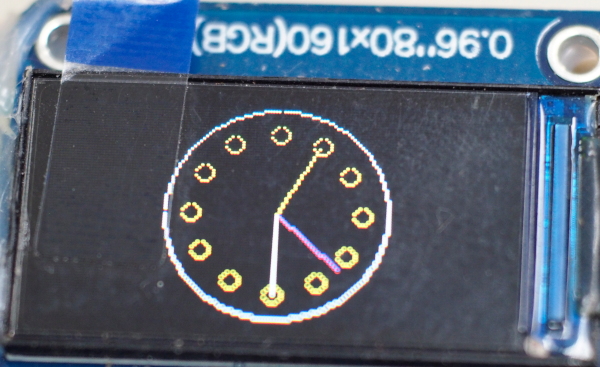
อุปกรณ์
อุปกรณ์การทดลองประกอบด้วย
- บอร์ด esp32
- จอแสดงผล TFT 0.96″
วาดนาฬิกาแอนาล็อก
จอแสดงผล TFT 0.96″ ใช้ไดรเวอร์ ST7735 เป็นตัวขับการทำงาน และในตัวอย่างนี้ใช้บอร์ดที่เป็น REDTAB ที่มีความละเอียด 80×160 จุด ทำให้ต้องสั่งหมุนจอ 90 องศาด้วยการสั่ง rotation(1)
วาดเรือนนาฬิกา
ตัวเรือนนาฬิกาแบ่งการวาดเป็น 2 ส่วน คือ ส่วนของตัวกรอบ และส่วนของเครื่องหมายจุดที่เป็นตัวแทนของตัวเลข 1 ถึง 12 ซึ่งเป็นตัวเลขบนหน้าปัดนาฬิกา
วาดกรอบ
ด้วยไลบรารีที่ใช้งานไม่มีคำสั่งวาดวงกลม จึงได้ใช้ขั้นตอนวิธีการวาดวงกลมแบบจุดกลาง (midpoint circle draw) จากเว็บไซต์ geeksforgeeks ได้เขียนไว้ดังนี้
def midPointCircleDraw(x_centre, y_centre, r):
x = r
y = 0
# Printing the initial point the
# axes after translation
print("(", x + x_centre, ", ",
y + y_centre, ")",
sep = "", end = "")
# When radius is zero only a single
# point be printed
if (r > 0) :
print("(", x + x_centre, ", ",
-y + y_centre, ")",
sep = "", end = "")
print("(", y + x_centre, ", ",
x + y_centre, ")",
sep = "", end = "")
print("(", -y + x_centre, ", ",
x + y_centre, ")", sep = "")
# Initialising the value of P
P = 1 - r
while x > y:
y += 1
# Mid-point inside or on the perimeter
if P <= 0:
P = P + 2 * y + 1
# Mid-point outside the perimeter
else:
x -= 1
P = P + 2 * y - 2 * x + 1
# All the perimeter points have
# already been printed
if (x < y):
break
# Printing the generated point its reflection
# in the other octants after translation
print("(", x + x_centre, ", ", y + y_centre,
")", sep = "", end = "")
print("(", -x + x_centre, ", ", y + y_centre,
")", sep = "", end = "")
print("(", x + x_centre, ", ", -y + y_centre,
")", sep = "", end = "")
print("(", -x + x_centre, ", ", -y + y_centre,
")", sep = "")
# If the generated point on the line x = y then
# the perimeter points have already been printed
if x != y:
print("(", y + x_centre, ", ", x + y_centre,
")", sep = "", end = "")
print("(", -y + x_centre, ", ", x + y_centre,
")", sep = "", end = "")
print("(", y + x_centre, ", ", -x + y_centre,
")", sep = "", end = "")
print("(", -y + x_centre, ", ", -x + y_centre,
")", sep = "")
จากโค้ดข้างต้นปรับแก้ใหม่ได้ดังนี้
def midPointCircleDraw(x_centre, y_centre, r, c):
x = r
y = 0
# When radius is zero only a single
# point be printed
if (r > 0) :
tft.setPixel(x + x_centre,-y + y_centre, c)
tft.setPixel(y + x_centre,x + y_centre, c)
tft.setPixel(-y + x_centre,x + y_centre, c)
# Initialising the value of P
P = 1 - r
while x > y:
y += 1
# Mid-point inside or on the perimeter
if P <= 0:
P = P + 2 * y + 1
# Mid-point outside the perimeter
else:
x -= 1
P = P + 2 * y - 2 * x + 1
# All the perimeter points have
# already been printed
if (x < y):
break
# Printing the generated point its reflection
# in the other octants after translation
tft.setPixel(x + x_centre,y + y_centre, c)
tft.setPixel(-x + x_centre, y + y_centre, c)
tft.setPixel( x + x_centre,-y + y_centre, c)
tft.setPixel( -x + x_centre,-y + y_centre, c)
# If the generated point on the line x = y then
# the perimeter points have already been printed
if x != y:
tft.setPixel(y + x_centre, x + y_centre, c)
tft.setPixel(-y + x_centre, x + y_centre, c)
tft.setPixel(y + x_centre, -x + y_centre, c)
tft.setPixel(-y + x_centre, -x + y_centre, c)
เมื่อปรับการแสดงผลด้วย pint เป็นคำสั่ง setPixel() และสั่งวาด midPointCircleDraw(80, 40, 39, tft.color(232,232,232)) ได้ผลลัพธ์ดังภาพที่ 2
วาดหมุด
การวาดหมุดชั่วโมงใช้การวาดวงกลมที่ตำแหน่ง 12 นาฬิกาเป็นวงกลมตำแหน่งเริ่มต้นดังภาพที่ 3 ซึ่งเขียนดังนี้
n12x = 80
n12y = 10
midPointCircleDraw(n12x, n12y, 3, tft.color(232, 232, 64))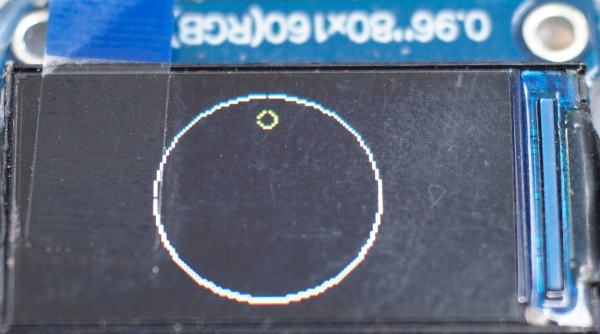
ส่วนตำแหน่งอื่น ๆ ใช้หลักการหมุนวงกลมไปตามองศาของการวางหมุดชั่วโมง นั่นหมายความว่า วงกลมมีองศาเป็น 360 องศา ต้องวาดหมุนจำนวน 12 จุด ดังนั้นแต่ละหมุดจะต้องหมุนองศาเป็นดังนี้
- องศา = 360/12
= 30
นั่นหมายความว่าจะต้องหมุน 30 องศา แล้ววาด 1 หมุด ทำทั้งหมด 12 ครั้ง
การตำนวณค่า (x,y) ใหม่สามารถใช้สมการคำนวณดังที่เคยกล่าวถึงในเรื่องของการหมุนสี่เหลี่ยมดังนี้
screenCenterX = 80
screenCenterY = 40
def rotate(pX,pY,angle):
rad = math.radians(angle)
pX -= screenCenterX
pY -= screenCenterY
xCos = pX*math.cos(rad)
ySin = pY*math.sin(rad)
xSin = pX*math.sin(rad)
yCos = pY*math.cos(rad)
newX = xCos - ySin + screenCenterX
newY = xSin + yCos + screenCenterY
return (int(newX), int(newY))เมื่อสั่งวาดด้วยคำสั่งต่อไปนี้จะได้ผลลัพธ์ดังภาพที่ 4
n12x = 80
n12y = 10
for i in range(12):
newX,newY = rotate( n12x, n12y, 30*i)
midPointCircleDraw( newX, newY, 3, tft.color(232, 232, 64))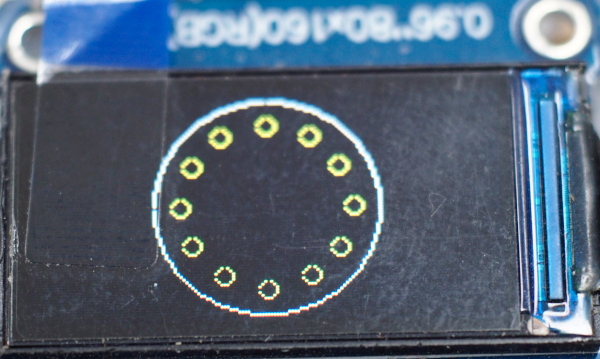
วาดเข็มวินาที
การวาดเข็มวินาทีใช้หลักการเดียวกับการคำนวณตำแหน่งของหมุดของตัวเลขชั่วโมง แต่ด้วย 1 ชั่วโมงมี 60 วินาที หมายความว่าจะต้องมีตำแหน่งของวินาที 60 ตำแหน่งใน 360 องศา ดังนั้น แต่ละตำแหน่งห่างกันตามสมการต่อไปนี้
- องศา = 360 / 60
= 6
ดังนั้น เมื่อรวมการวาดเส้นตรงจากตำแหน่งกึ่งกลางของจอ และปลายเข็มอยู่ที่วินาทีที่ sec สามารถเขียนโค้ดได้ดังนี้
def drawSecond( sec ):
deg = sec * 6
n12x = 80
n12y = 10
newX,newY = rotate( n12x, n12y, deg)
print(i, deg, newX, newY)
tft.line((screenCenterX, screenCenterY), (newX, newY), tft.color(232, 64, 232))เมื่อเขียนโค้ดให้แสดงเข็มวินาทีดังต่อไปนี้จะได้ตัวอย่างผลลัพธ์ดังภาพที่ 5
for i in range(60):
tft.fill(tft.BLACK)
drawClock()
drawSecond(i)
tft.swap()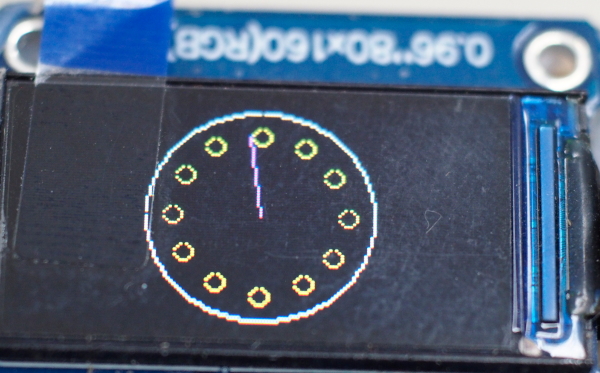
วาดเข็มนาที
เข็มนาทีใช้การคำนวณเหมือนวินาที แต่ขยับทุกครั้งที่เข็มวินาทีวนครบ 1 รอบ ดังนั้น การวาดเข็มนาทีเขียนได้ดังนี้
def drawMinute( minute ):
deg = minute * 6
n12x = 80
n12y = 10
newX,newY = rotate( n12x, n12y, deg)
tft.line((screenCenterX, screenCenterY), (newX, newY), tft.color(232, 242, 232))การกำหนดความสัมพันธ์ระหว่างค่าวินาทีกับนาทีเขียนดังนี้
minute = 10
for nLoop in range(300):
for sec in range(60):
tft.fill(tft.BLACK)
drawClock()
drawSecond(sec)
drawMinute(minute)
tft.swap()
minute += 1วาดเข็มชั่วโมง
เข็มชั่วโมงคำนวณตำแหน่งเหมือนการวาดหมุด และมีความสัพธ์กับค่านาที คือ เมื่อนาทีครบ 1 รอบจะเพิ่มค่าชั่วโมงขึ้น 1 และถ้าค่าชั่วโมงมากกว่า12 ให้กลับไป 1 และตัวอย่างผลลัพธ์เป็นดังภาพที่ 1
ตัวอย่างโปรแกรม
ตัวอย่างโปรแกรมทำการแสดงนาฬิกาโดยเริ่มตั้งเวลาไว้ที่ 1:30.00 และใช้การเพิ่มค่าวินาทีจากการใช้การตั้งเวลา 1 วินาที (อ่านบทความ) จึงได้โค้ดผลลัพธ์เป็นดังนี้ และตัวอย่างของการแสดงผลเป็นดังภาพที่ 1
from ST7735 import TFT
import machine as mc
from machine import SPI,Pin, Timer
import time
import math
#################################################################
###### setting ##################################################
#################################################################
mc.freq(240000000)
spi = SPI(2, baudrate=26000000,
sck=Pin(14), mosi=Pin(12),
polarity=0, phase=0)
# dc, rst, cs
tft=TFT(spi,15,13,2)
screenCenterX = 80
screenCenterY = 40
second = 0
minute = 30
hour = 1
#################################################################
###### sub modules ##############################################
#################################################################
def midPointCircleDraw(x_centre, y_centre, r, c):
x = r
y = 0
tft.setPixel(x + x_centre,y + y_centre, c)
# When radius is zero only a single
# point be printed
if (r > 0) :
tft.setPixel(x + x_centre,-y + y_centre, c)
tft.setPixel(y + x_centre,x + y_centre, c)
tft.setPixel(-y + x_centre,x + y_centre, c)
# Initialising the value of P
P = 1 - r
while x > y:
y += 1
# Mid-point inside or on the perimeter
if P <= 0:
P = P + 2 * y + 1
# Mid-point outside the perimeter
else:
x -= 1
P = P + 2 * y - 2 * x + 1
# All the perimeter points have
# already been printed
if (x < y):
break
# Printing the generated point its reflection
# in the other octants after translation
tft.setPixel(x + x_centre,y + y_centre, c)
tft.setPixel(-x + x_centre, y + y_centre, c)
tft.setPixel( x + x_centre,-y + y_centre, c)
tft.setPixel( -x + x_centre,-y + y_centre, c)
# If the generated point on the line x = y then
# the perimeter points have already been printed
if x != y:
tft.setPixel(y + x_centre, x + y_centre, c)
tft.setPixel(-y + x_centre, x + y_centre, c)
tft.setPixel(y + x_centre, -x + y_centre, c)
tft.setPixel(-y + x_centre, -x + y_centre, c)
def rotate(pX,pY,angle):
rad = math.radians(angle)
pX -= screenCenterX
pY -= screenCenterY
xCos = pX*math.cos(rad)
ySin = pY*math.sin(rad)
xSin = pX*math.sin(rad)
yCos = pY*math.cos(rad)
newX = xCos - ySin + screenCenterX
newY = xSin + yCos + screenCenterY
return (int(newX), int(newY))
def drawClock():
midPointCircleDraw(80, 40, 39, tft.color(232,232,232))
n12x = 80
n12y = 10
for i in range(12):
newX,newY = rotate( n12x, n12y, 30*i)
midPointCircleDraw( newX, newY, 3, tft.color(232, 232, 64))
def drawSecond( sec ):
deg = sec * 6
n12x = 80
n12y = 10
newX,newY = rotate( n12x, n12y, deg)
tft.line((screenCenterX, screenCenterY), (newX, newY), tft.color(232, 64, 232))
def drawMinute( minute ):
deg = minute * 6
n12x = 80
n12y = 10
newX,newY = rotate( n12x, n12y, deg)
tft.line((screenCenterX, screenCenterY), (newX, newY), tft.color(232, 242, 232))
def drawHour( hour ):
deg = hour * 30
n12x = 80
n12y = 12
newX,newY = rotate( n12x, n12y, deg)
tft.line((screenCenterX, screenCenterY), (newX, newY), tft.color(232, 242, 64))
def cbSecond(x):
global second, minute, hour
second += 1
if (second == 60):
second = 0
minute += 1
if (minute == 60):
minute = 0
hour += 1
if (hour == 12):
hour = 0
tft.fill(tft.BLACK)
drawClock()
drawSecond(second)
drawMinute(minute)
drawHour(hour)
tft.swap()
#################################################################
###### main program #############################################
#################################################################
secTmr = Timer(0)
secTmr.init( period=1000, mode=Timer.PERIODIC, callback=cbSecond)
while True:
pass
สรุป
จากบทความนี้ จะพบว่า การแสดงผลอาศัยการคำนวณเพื่อใช้ในการวาดวงกลม และตำแหน่งต่าง ๆ ของหมุดชั่วโมง เข็มวินาที เข็มนาที และเข็มชั่วโมง พร้อมทั้งได้ใช้งานตัวตั้งเวลาเป็นตัวเพิ่มค่าววินาที ซึ่งมีความสัมพันธ์กับการแสดงค่านาทีและชั่วโมงที่ขึ้นต่อกัน โดยทีมพวกเราหวังว่า ผู้อ่านจะสามารถนำไปปรับปรุงเพื่อใช้งานต่อไป สุดท้ายขอให้สนุกกับการเขียนโปรแกรมครับ
แหล่งอ้างอิง
- geeksforgeeks : mid-point circle drawing algorithm
(C) 2020-2021, โดย อ.ดนัย เจษฎาฐิติกุล/อ.จารุต บุศราทิจ
ปรับปรุงเมื่อ 2021-11-03, 2022-01-03
